Hinduism › Rama » Ancient origins
Articles and Definitions › Contents
- Hinduism › Antique Origins
- Rama › Who Was
Ancient civilizations › Historical and archaeological sites
Hinduism › Antique Origins
Definition and Origins
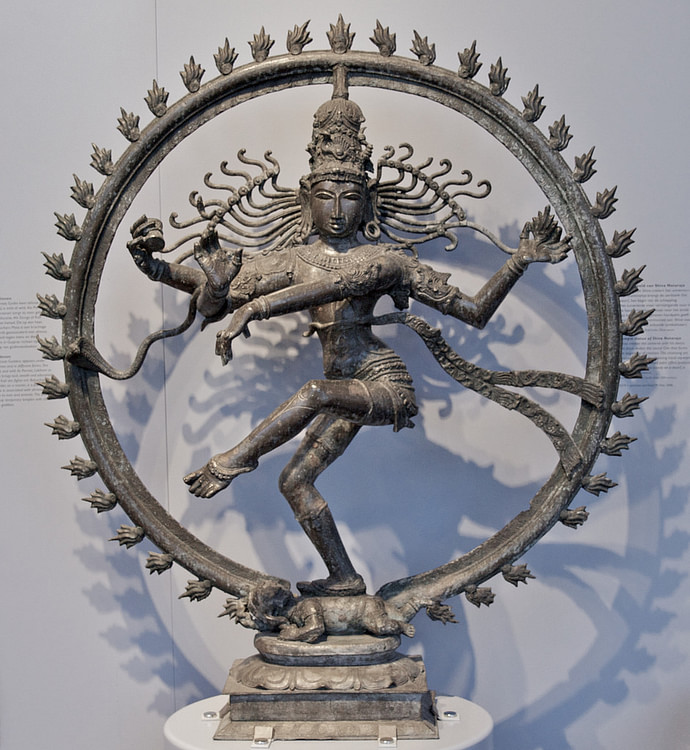
Unlike other religious traditions, Hinduism does not originate in a single founder, a single book or a single point in time. It contains many different beliefs, philosophies and viewpoints, not always consistent with each other. These apparent contradictions strike only those who are not familiar with this tradition: the Hindu insight claims that the Oneness expresses itself in many different forms.
Hinduism is often labelled as a religion, but it is actually more than that: it is a vast and complex socio-religious body which, in a way, reflects the complexity of Indian society. A rich geography, many languages and dialects, lots of different creeds, racial diversity, all these elements have shaped Hinduism and made it so heterogenic. The lack of unifying overall religious authority and the total absence of a book claiming supreme truth and dogmas have contributed to the diversity of Hinduism as well. It is fair to mention that even the texts we find in Hinduism that claim some sort of divine inspiration do not declare their view to be better than any other and they all exist together in a tolerant fashion. The many manifestations of Hinduism go from highly intellectual philosophies concerning numerous and puzzling metaphysical concerns, many rituals, mental and physical exercises such as Yoga to simple, almost childlike, tales and legends.
THE FOUNDATIONS OF HINDUISM CAN BE FOUND IN THE TEACHINGS OF ANONYMOUS ANCIENT SAGES OR RISHIS.
This tradition has come down to us from prehistoric times. The foundations of Hinduism can be found in the teachings of anonymous ancient sages or rishis, which were originally transmitted orally. We know very little about Hinduim beyond what can be learned from the Vedas, a collection of hymns and other ritual texts composed in different periods. These texts contain a lot of material including the teachings of the early sages. The oldest evidence of religious practices in India date back approximately to 5500 BCE. It is a mistake to reduce all early Hinduism to Vedic religion: there were many other non-Vedic religious traditions in early Hinduism which have left no early texts and that can be known to some extent by archaeological evidence.
Just like Zoroastrianism and Judaism (the other two major world religions also coming to us from prehistoric times), Hinduism has received numerous shocks that threatened its foundations and it has resiliently survived all of them. Judaism and Zoroastrianism also survived the many impacts they received, but Judaism failed to absorb Christianity, its all-conquering offspring, which after just a couple of centuries clearly overshadowed it, and there are only around 200,000 Zoroastrian believers left today. The basis of Hinduism has been hit, sometimes even smashed, by many sects, movements and systems of thought: in the worst case scenarios it receded for a while, only to return more powerful than before. Movements challenging the authority of the priestly orthodoxy, irreligious schools such as the Charvaka, atheist traditions like Jainism, the Buddhistagnostic approach, nihilists and skeptics denouncing the cunning behind the sacrificial fees, all of these beliefs weakened Hinduism for some time and were eventually absorbed, recycled and merged into the enormous body of this old Indic faith.
DARSÁN : THE EMPHASIS OF THE VISUAL EXPERIENCE
We read in the Brahmanas, a group of sacred priestly texts attached to the Vedas :
The eye is the truth. If two persons come disputing with each other [...] we should believe him who said 'I have seen it', not him who has said 'I have heard it.'
Hinduism attaches a very special value to the the darsán (a sanskrit word meaning sight), of gurus, leaders, saintly persons and even holy places and holy images. According to the Hindus, darsán is a two-way flow of vision. While the devotee sees the god, so too the god sees the devotee, and the two can make contact through their eyes. When the images of the gods are made, its eyes are the last part to be completed. It is not until the image is consecrated that its eyes are finally opened with either the touch of a paintbrush or using a golden needle. Popular gods like Shiva and Ganesha have a third eye located in their forehead. The god Brahma, the Thousand-Eyes, often has four heads and looks in all directions at once. This emphasis on the vision and the image dominates the Hindu's relation to the gods, appearing to be just the opposite of many other religions.
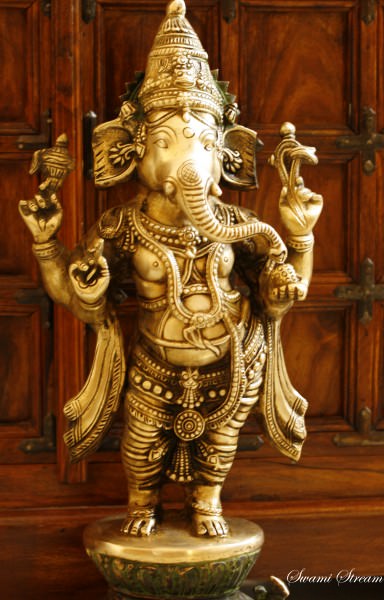
Ganesha
MANY IS BETTER THAN ONE
Abrahamanic religions are dominated by the notion that One is better than many: One God, One Book, One Son, One Church, One Nation of God. In Hinduism, the more the better: many gods, many books, many sages, many insights.
In this ever-growing community of endless gods and goddesses, the roles of the gods and even their hierarchy are somehow diffuse. Some gods get more attention than others and different accounts suggest different hierarchies. Olympian gods, who had a clear hierarchy, may look greedy and envious compared with the tolerant gods of Hinduism.
Agni, Indra, Shiva, Brahma, Vishnu and Ganesha are just a few examples of very important Hindu gods that were regarded at different times and by different sects as the most important gods. Shiva, Vishnu and Brahma were part of a holy Hindu trinity (trimurti). Shiva is sometimes associated with the destruction process and Vishnu as the creator who takes the remains destroyed by Shiva in order to regenerate what has been destroyed. For the Ganapatya Hindu sect, Ganesha is the most important deity. Ganesha is highly recognizable with his elephant head and human body, representing the soul ( atman ) and the physical ( maya ) respectively. He is also the patron of writers, travellers, students, commerce, and new projects (for which he removes obstacles from one's path) and is rather fond of sweets, to the slight detriment of his figure.
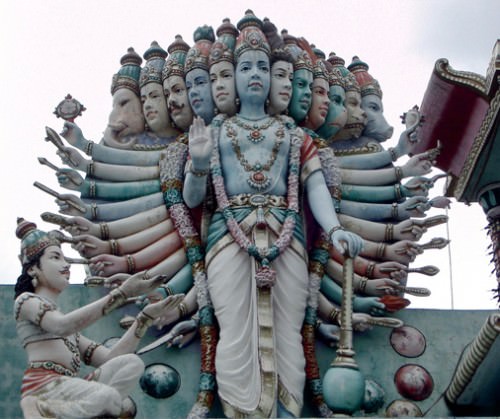
Krishna manifesting his full glory to Arjuna
THE RIDDLE OF CREATION
Trying to answer the big questions of life, Hinduism offers several different accounts for the origin of the universe. Here we also see traces of the complexity of Hinduism: the question has been approached in so many different ways.
One account says the universe came into existence as a result of the sacrifice of a primeval being, Purusha, who existed even before time. The gods appear to have been his children. Purusha is dismembered by the gods. Purusha's mind became the Moon, his eyes the Sun, the Sky came from his head, and the Earth came from his feet.
There is a famous creation quote in the Rig- Veda which suggests a certain skepticism on whether the origin of the universe is a knowable topic.
Then was not non-existent nor existent: there was no realm of air, no sky beyond it.
What covered in, and where? and what gave shelter? Was water there, unfathomed depth of water? [...]
Who verily knows and who can here declare it, whence it was born and whence comes this creation?
The Gods are later than this world's production. Who knows then whence it first came into being?
He, the first origin of this creation, whether he formed it all or did not form it,
Whose eye controls this world in highest heaven, he verily knows it, or perhaps he knows not.(Rig-Veda 10.129.1-7)
It seems quite an extraordinary idea that even the gods, even the Highest Seer in the Highest Sky, could possibly not know it all.
There is another account on how the universe started, which has no equivalent in any other tradition. The universe is actually the dream of a god who after 100 Brahma years, dissolves himself into a dreamless sleep, and the universe dissolves with him. After another 100 Brahma years, he recomposes himself and begins to dream again the great cosmic dream. Meanwhile, there are infinite other universes elsewhere, each of them being dreamt by its own god.
This idea could actually reverse the cause and the effect, since humans may not be the result of the dreams of the gods, but rather the gods may be the result of the dreams of humans.
Rama › Who Was
Definition and Origins
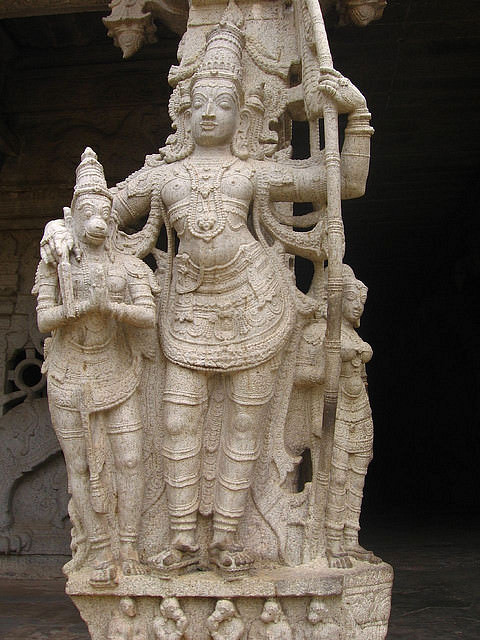
Rama (or Ramacandra) is the seventh avatar of the Hindu god Vishnu. His adventures, notably the slaying of the demon king Ravana, are recounted in the Vana Parva of the Mahabharata and in the Ramayana, the oldest Sanskrit epic, written sometime in the 5th century BCE but with some later additions. Lord Rama, considered by many Hindus to be based on an historical figure, is perhaps the most virtuous hero from Hindu mythology and he, along with his wife Sita, are a picture of purity and marital devotion. Further, the adventures of Rama illustrate above all the importance and rewards of fulfilling one's pious duty or dharma.
RAMA'S FAMILY
Rama's father is King Dasaratha, a prince of the solar race, and his mother is Queen Kausalya. Rama was born at the end of the Second Age or Treta-yuga and he came into the world specifically at the bidding of the gods to deal with the fearsome multi-headed demon Ravana, the king of Lanka (modern Sri Lanka). The great god Vishnu answered the gods' call and appeared in a sacrificial fire made by Dasaratha. The pious king was presented with a pot of nectar, and he gave half of it to Kausalya who produced half-divine Rama as a consequence. Rama had three half-brothers – Bharata, Lakshmana, and Shatrughna - all with some, albeit lesser, divine qualities. Rama's favourite brother and great companion was Laksmana, son of Sumitra, while his loyal servant was the monkey warrior Hanuman (or Hanumat).
RAMA MEETS SITA
Rama's first adventure occurred when the sage Visvamitra asked for help in fighting a demon or raksasa. Rama and Laksmana, leaving their childhood home at Ayodhya capital of the northern kingdom of Koshala, followed Visvamitra to his home and there killed Taraka, a terrible female demon. In gratitude Rama was given divine weapons, and he set off for more adventures, ending up in Mithila. There Janaka the king of Videha hosted our hero, and he met the king's beautiful daughter Sita (also called Janaki or Maithili). The king had promised the princess in marriage to anyone who could manage to bend a huge bow which had once been the weapon of the great god Shiva. Rama, with his divine strength, did more than just bend the bow but broke it in half and so won the hand of Sita, his first and most revered wife.
'RAMA, THE BEST OF UPHOLDERS OF DHARMA, THE MASTER OF THE WORLD' RAMAYANA
RAMA'S EXILE
Rama's succession to the throne of Ayodhya was made difficult by his mother's hunchback slave Manthara. Jealous of Rama, she soured the opinion of Kaikeyi, Dasaratha's second wife, and convinced her to persuade her husband to instead make Bharata heir to the throne. On top of this slight Rama was exiled from the kingdom for fourteen years. So, accompanied by Sita and his ever faithful companion Laksmana, Rama went to live in the far south in Citrakuta, deep in the Dandaka forest.Meanwhile, Dasaratha died, but Bharata, seeing the injustice of Rama's treatment, decided not to become king but instead to search for and return Rama to his rightful home and birthright. When the two brothers met once again, Rama obstinately refused to return to Ayodhya until he had fulfilled his father's wishes and served out his fourteen years of exile. After much discussion, Bharata agreed to act as regent until that time, and to prove to his subjects Rama's decision, he took his brother's shoes as a symbol of Rama's royal status.
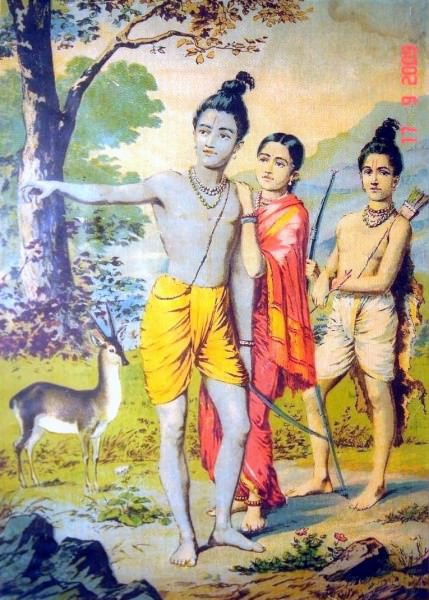
Rama, Sita, & Laksmana
RAMA & RAVANA CLASH
Rama did not stay still in the remainder of his exile but visited many sages. Eventually, he ended up at Pancavati along the river Godavari, an area plagued by demons. One in particular, Surpanakha, the sister of Ravana, fell in love with Rama, and when her advances were resisted, she attacked Sita in revenge. Laksmana was the first to react and cut off the ears and nose of Surpanakha. Not best pleased with this treatment, the enraged demoness gathered an army of demons to attack the trio. In an epic battle Rama defeated them all; however, Surpanakha was not finished with the matter and she persuaded Ravana that Sita was a girl worth fighting for. Accordingly, the demon king sought out Rama's home, and while Rama was distracted in the hunt for a deer (who was actually Ravana's magician Maricha in disguise), abducted Sita, taking her back to Lanka in his aerial chariot to be kept captive in his beautiful Ashoka garden.
Rama followed in hot pursuit but met several troublesome distractions along the way. The first was the headless monster Kabandha. Killing the creature, its departing soul proved more helpful and advised Rama that before confronting Ravana, our hero should enlist the help of Sugriva, king of the monkeys. Finding on their arrival at Sugriva's capital Kiskindha that the king had lost his throne to his brother Balin, Rama helped restore Sugriva to power. A grateful Sugriva gave Rama use of an army and enlisted the help of Hanuman, who besides being an able general was the son of the wind and able to leap huge distances and take any form he wished. It was he who magically transported Rama and his force to Lanka, crossing the rock bridge built by the skilled general Nala, son of Visvakarma, which became known as Rama's Bridge.
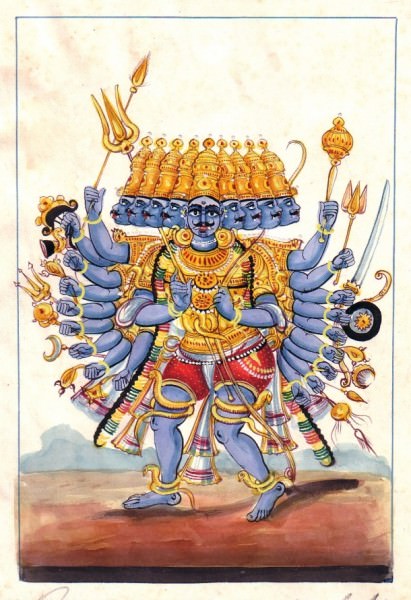
Ravana the Demon King
A series of titanic battles between Rama's forces and the demons followed, but eventually Ravana was slain, Lanka fell to Rama's army, and our hero was reunited with his wife. Rama was not entirely convinced that his wife had remained loyal to him during her abduction, but Sita determined to prove her honour by a test of fire, indeed the divine fire of Agni, no less.Escaping the flames unscathed, Rama realized he had misjudged Sita, and the couple headed back for Ayodhya where Rama reclaimed his throne and began a golden era of government.
According to the Uttara Kanda the story continues with Rama still harbouring suspicions about his wife's virtue during her captivity with Ravana. Rama thus exiles Sita to live with the sage Valmiki, and it is there that she bears him twin sons, Kusa and Lava. Eventually the sons return to Ayodhya where Rama recognizes his offspring and, in a fit of remorse, recalls the wronged Sita. In the Ramayana everyone lives happily ever after at this point, but in the Uttara Kanda the tale is not quite finished. Still proclaiming her innocence, Sita now swears her virtue on the earth itself which then promptly swallows her by opening beneath her feet. Rama, now even more distraught, vows to follow his wife to heaven, but Time appears to him in the guise of an ascetic and calls for him to remain and fulfil his duty on earth. Nevertheless, Rama wades into the river Sarayu and from there is welcomed into heaven by Brahma.
WORSHIP & REPRESENTATION IN ART
Rama remains a figure of worship across India and South-east Asia but especially in Oude and Bihar. He has, for example, a magnificent temple at Ramesvaram, notable for its 17th century CE columned corridor. In addition, the Ramanandis are the largest and perhaps strictest Vaishnava monastic order. Rama is also considered by some Buddhists to be an avatar of Buddha, and sculptures of the hero sometimes appears on the exterior of Buddhist temples.
In art Rama is always youthful and typically has green or blue skin, holds a bow and arrows, and wears a yellow robe. He is most often seen with Sita, Laksmana, and Hanuman – collectively known as Rama's family or Rama Parivara. Episodes from the Ramayana are especially popular in Hindu sculpture, wall paintings, and art in general, most of all forest scenes with Rama hunting the deer and the epic battle with Ravana.
LICENSE:
Article based on information obtained from these sources:with permission from the Website Ancient History Encyclopedia
Content is available under License Creative Commons: Attribution-NonCommercial-ShareAlike 3.0 Unported. CC-BY-NC-SA License